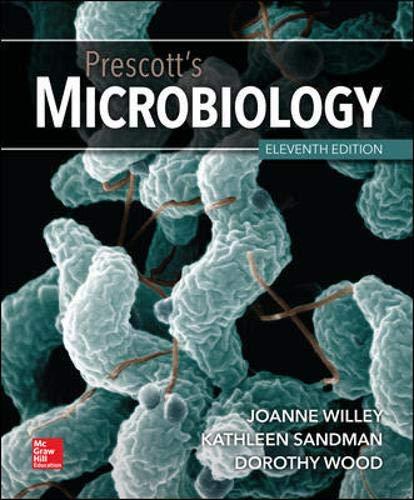
Prescott's Microbiology
11th Edition
ISBN: 9781260211887
Author: WILLEY, Sandman, Wood
Publisher: McGraw Hill
expand_more
expand_more
format_list_bulleted
Concept explainers
Question
Chapter 38.3, Problem 2CC
Summary Introduction
To determine: The reason for recurrent cold sores in people.
Introduction: Cold sore or a fever blister is a fluid-filled lesion that is commonly formed at the lips or the inside of nostrils. Cold sores present themselves near the nerve endings. As a result, they cause significant itching and burning sensation.
Summary Introduction
To determine: The causative agents of cold sores.
Introduction: Viruses consists of
Expert Solution & Answer
Want to see the full answer?
Check out a sample textbook solution
Students have asked these similar questions
The following table is from Kumar et. al. Highly Selective Dopamine D3 Receptor (DR) Antagonists and Partial Agonists Based on Eticlopride and the D3R Crystal Structure: New Leads for Opioid Dependence Treatment. J. Med Chem 2016.
The following figure is from Caterina et al. The capsaicin receptor: a heat activated ion channel in the
pain pathway. Nature, 1997. Black boxes indicate capsaicin, white circles indicate resinferatoxin.
You are a chef in a fancy new science-themed restaurant. You have a recipe that calls for 1 teaspoon of resinferatoxin, but you feel uncomfortable serving foods with "toxins" in them. How much capsaicin could you substitute instead?
What protein is necessary for packaging acetylcholine into synaptic vesicles?
Chapter 38 Solutions
Prescott's Microbiology
Ch. 38.1 - Prob. 1MICh. 38.1 - Why is it thought that the characteristic rash is...Ch. 38.1 - Prob. 3MICh. 38.1 - Prob. 1CCCh. 38.1 - Prob. 2CCCh. 38.1 - Prob. 3CCCh. 38.1 - Prob. 4CCCh. 38.1 - Prob. 5CCCh. 38.1 - Prob. 6CCCh. 38.1 - Prob. 7CC
Ch. 38.3 - Prob. 1MICh. 38.3 - Prob. 2MICh. 38.3 - Prob. 1CCCh. 38.3 - Prob. 2CCCh. 38.3 - Prob. 3CCCh. 38.3 - Prob. 4CCCh. 38.3 - Prob. 5CCCh. 38.3 - Prob. 6CCCh. 38.4 - Prob. 1CCCh. 38.4 - Prob. 2CCCh. 38.4 - Prob. 3CCCh. 38.4 - Prob. 4CCCh. 38.5 - Prob. 1MICh. 38.5 - Prob. 1CCCh. 38.5 - Prob. 2CCCh. 38.5 - Prob. 3CCCh. 38.6 - How are prions different from viruses? How are...Ch. 38.6 - In what way are spongiform encephalopathies...Ch. 38 - Prob. 1RCCh. 38 - Prob. 2RCCh. 38 - Prob. 3RCCh. 38 - Prob. 1ALCh. 38 - Prob. 2ALCh. 38 - Prob. 3ALCh. 38 - Prob. 4ALCh. 38 - Prob. 5ALCh. 38 - Prob. 6AL
Knowledge Booster
Learn more about
Need a deep-dive on the concept behind this application? Look no further. Learn more about this topic, biology and related others by exploring similar questions and additional content below.Similar questions
- 1. Match each vocabulary term to its best descriptor A. affinity B. efficacy C. inert D. mimic E. how drugs move through body F. how drugs bind Kd Bmax Agonist Antagonist Pharmacokinetics Pharmacodynamicsarrow_forward50 mg dose of a drug is given orally to a patient. The bioavailability of the drug is 0.2. What is the volume of distribution of the drug if the plasma concentration is 1 mg/L? Be sure to provide units.arrow_forwardDetermine Kd and Bmax from the following Scatchard plot. Make sure to include units.arrow_forward
- Choose a catecholamine neurotransmitter and describe/draw the components of the synapse important for its signaling including synthesis, packaging into vesicles, receptors, transporters/degradative enzymes. Describe 2 drugs that can act on this system.arrow_forwardThe following figure is from Caterina et al. The capsaicin receptor: a heat activated ion channel in the pain pathway. Nature, 1997. Black boxes indicate capsaicin, white circles indicate resinferatoxin. a) Which has a higher potency? b) Which is has a higher efficacy? c) What is the approximate Kd of capsaicin in uM? (you can round to the nearest power of 10)arrow_forwardWhat is the rate-limiting-step for serotonin synthesis?arrow_forward
arrow_back_ios
SEE MORE QUESTIONS
arrow_forward_ios
Recommended textbooks for you
- Surgical Tech For Surgical Tech Pos CareHealth & NutritionISBN:9781337648868Author:AssociationPublisher:CengageCase Studies In Health Information ManagementBiologyISBN:9781337676908Author:SCHNERINGPublisher:Cengage
 Medical Terminology for Health Professions, Spira...Health & NutritionISBN:9781305634350Author:Ann Ehrlich, Carol L. Schroeder, Laura Ehrlich, Katrina A. SchroederPublisher:Cengage Learning
Medical Terminology for Health Professions, Spira...Health & NutritionISBN:9781305634350Author:Ann Ehrlich, Carol L. Schroeder, Laura Ehrlich, Katrina A. SchroederPublisher:Cengage Learning


Surgical Tech For Surgical Tech Pos Care
Health & Nutrition
ISBN:9781337648868
Author:Association
Publisher:Cengage

Case Studies In Health Information Management
Biology
ISBN:9781337676908
Author:SCHNERING
Publisher:Cengage



Medical Terminology for Health Professions, Spira...
Health & Nutrition
ISBN:9781305634350
Author:Ann Ehrlich, Carol L. Schroeder, Laura Ehrlich, Katrina A. Schroeder
Publisher:Cengage Learning